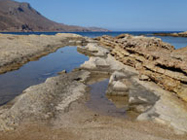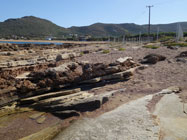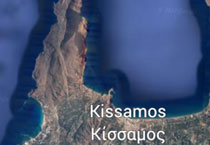|
||||||||||||
|
Page 1/5
|
Looking for the northern ape-man webpage 2/5
Text, photography: Annemieke van Roekel
Tracks in the Venetian fort 

near the waterline in the Bay of Kissamos. Fig. 6. Detail. Photo: A. van Roekel. Enclosed between two peninsulas Trachilos and Kissamos are located on the west side of the Bay of Kissamos, which is bordered on both sides by peninsulas that run about 15 km into the sea: Gramvousa in the west and Rodopos in the east. Paleographic maps show that both peninsulas must have been connected to the Greek mainland millions of years ago. They are both made up of rocks from the Tripolitsa Unit, one of the five pre-Alpine nappes on Crete. The geology of the Bay of Kissamos is of Neogene age. Kissamos (formerly Kastelli-Kissamos due to the presence of the Venetian fortress) is an hour's drive west of Chania. It is also less than an hour from Phalassarna, an important port that flourished in the third and fourth century BC. Excavations, which are still ongoing, uncovered the harbor, which is now about 6 m above sea level. The bollards on which the ships were moored are now also high and up. Its location far above sea level is explained by the infamous earthquake of 365 AD, which is considered to have destroyed many cities (also outside Crete) and caused a large part of western Crete to be raised. Ancient Kissamos was also destroyed in 365 AD. At present, much is being excavated in Kissamos and the ancient coastline has been located. In the city, for example, a bathhouse with earthquake traces, a Roman courtyard and a house with a mosaic floor have been uncovered. At one of the hotels in the west part of town there are remnants of a harbor in the water. 

New hypothesis But back to the footprints! Trachilos' footprints (Figs. 7 and 8) are particularly important to paleoanthropologists because they support an exciting hypothesis about human evolution. Indeed, they are possible evidence of the presence of an upright walking early human species in Europe during the late Miocene, perhaps even related to the common ancestor of humans and chimpanzees. In doing so, they can contribute to a 'paradigm shift' in palaeoanthropology, in which the focus of Africa as the cradle of bipedalism is shifting to the more northern latitudes. The footprints of Trachilos are millions of years older than the famous footprints of Laetoli (Tanzania), of Australopithecus, of which bone fossils are also available, and which are dated at 3.6 million years. It took the authors of the first article on the 'Trachilos tracks' (Gierlinski, et al., 2017) about seven years to publish their article on the subject in a scientific journal. In a very recent article (McNutt et al., 2021) on a new study of Laetoli footprints previously identified as bears, the Trachilos tracks were not mentioned, much to the frustration of Per Ahlberg, professor at Uppsala University in Sweden and specialist in ichnofossils of Palaeozoic tetrapods. Ahlberg is co-author of the articles on the Trachilos tracks (2017 and 2021) and believes that the Laetoli-2 prints, which are much deeper and were made in volcanic ash, bear a close resemblance in shape to the prints on Trachilos Beach, despite the 2.5 million years of age difference and the fact that volcanic ash doesn't keep the details very well. Page 1/5 Page 2/5 (this page) Page 3/5 Page 4/5 Page 5/5 Last update: April 16, 2022 |
|||||||||||
